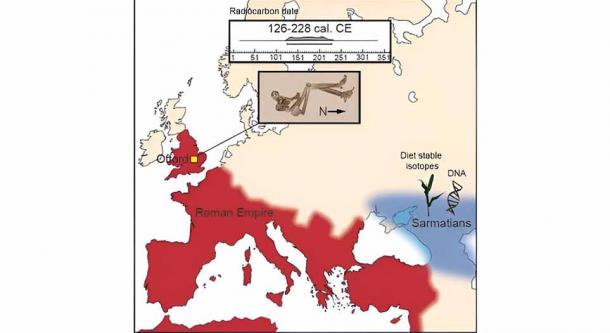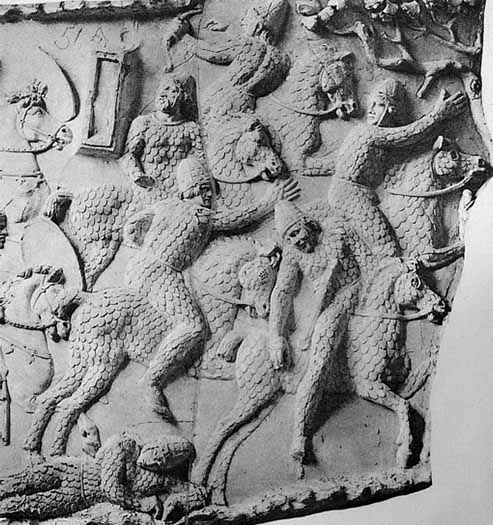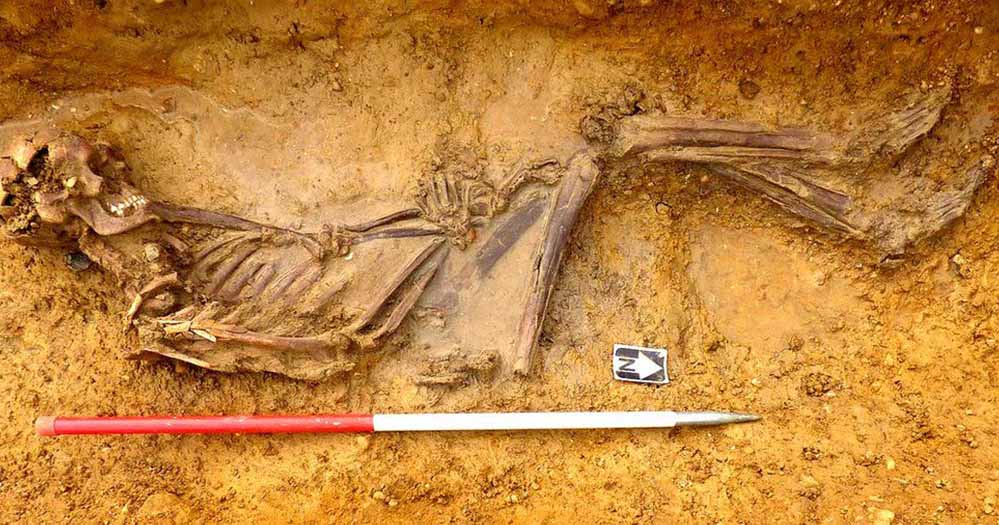After completing a DNA analysis of the remains of an individual who was buried near the village of Offord Cluny in Cambridgeshire, England in the second century AD, a team of scientists discovered something quite surprising. It seems this Roman-era resident was not a native of the British Isles, nor was he a settler from Rome, but instead came from somewhere far to the east, quite possibly from the Caucasus Mountain region of what is now Russia. This migrant man is now known to have lived sometime between the years 126 and 228 AD, and his genetic materials identify him as belonging to an ancient ethnic group known as the Sarmatians.
The Sarmatians were a Iranian-speaking, horse-riding, Scythian nomadic people who lived mainly in what is now southern Russia and the Ukraine, or in the Caucasus. While they were known to wander about Central Asia and Eastern Europe quite readily, this is the first evidence found that proves the Sarmatians traveled all the way to Britain in the west.
In the second century AD the Russian frontier represented the farthest northeastern reaches of the Roman Empire. The presence of Sarmatians in both the far east and the far west of Roman lands shows they must have traveled the length and breadth of the Empire looking for adventure or opportunity.
Archaeologists excavate the Offord Cluny 203645 burial. Their work has revealed he was a Sarmatian. (MOLA Headland Industry)
Offord Cluny 203645 and the Secrets Hidden in His DNA
The remains of the man whose DNA revealed these eye-opening results were discovered in 2017, during excavations connected to a large-scale, ongoing infrastructure project (the National Highways A14 Cambridge to Huntington Improvement Scheme) that was passing through Cambridgeshire county in eastern England.
This individual’s gravesite was located near an ancient rural farmstead, which naturally fueled speculation that he was a local farmer who’d been buried in a field near his second- or third-century AD home. He was found buried in a track ditch all by himself, and not in a cemetery shared by other deceased individuals. He was given the name Offord Cluny 203645, in recognition primarily of where his remains were unearthed.
To confirm the man’s identity, genetic testing was performed on his skeletal remains, by a team of scientists from the Francis Crick Institute in London, Durham University and the organization MOLA Headland Infrastructure, which handles archaeological excavations connected to infrastructure projects in England.
“We began by extracting and sequencing ancient DNA (aDNA) from the bone of the individual’s inner ear, as this is where it is best preserved,” Marina Soares de Silva, a postdoctoral researcher in the Ancient Genomes Lab at the Francis Crick Institute, explained in an Institute press release. “This is not like testing the DNA of someone who is alive, as the DNA is very fragmented and damaged. However, we were able to sequence enough of his DNA to good quality and compared it to samples of people who lived at different times and places in the past.”

Researchers revealed Sarmatian individual unearthed in Cambridgeshire ate plants available in Sarmatia within Western or Northern Europe (in blue) until the age of 5 or 6. (Marina Silva et al. /Current Biology)
A Sarmatian Child Comes to Maturity in Roman Britain
In an article just published in the journal Current Biology, the researchers revealed the results of their testing, which proved—much to everyone’s surprise—that the man had not been born in England, nor had he lived there during much of his life. He had instead come from lands that were thousands of miles away, on the far fringes of the mighty Roman Empire.
“Genetically he was very different to the other Romano-British individuals studied so far,” Soares de Silva stated. “In fact, our analysis showed that he had common ancestors with previously studied individuals from the Caucasus and Sarmatian groups.”
While the results of this testing proved some sort of migration had taken place, most likely in the second century, the DNA results alone weren’t enough to prove the man had been born elsewhere. It was possible that his parents had come to Roman Britain in earlier times, and gave birth to a son while living on British soil.
Using other methods of analysis, archaeologists from Durham University were able to provide some answers to the mysteries of this individual’s life history. From a study of his teeth, they discovered that the deceased Sarmatian had absorbed isotopes from elements like carbon, nitrogen, strontium and oxygen that linked him to a far eastern location. These tests showed that he’d grown up in an environment that was different than that found in Roman era Britain, and that at one time he’d consumed a different type of diet.
Although the man had lived in the Caucacus region at one time, the tests revealed he had in fact arrived in Roman Britain in the company of his parents or guardians, while he was still a child. He’d then finished growing up in Britain, a true citizen of two different continents.
“This is an exciting study that very effectively combines aDNA and isotope evidence,” Durham University archaeologist Janet Montgomery said. “Until the age of 5 or 6, he lived in an arid location in the east of continental Europe. His diet at this age contained a lot of C4 crops, such as millet and sorghum, which are not native to Europe. As he grew up, he migrated west, and these plants disappeared from his diet.”
Interestingly, previous testing on other Roman-era skeletal remains found in Britain have produced evidence showing the deceased individuals consumed a C4-style diet. Up to now researchers have been baffled by this curious fact, but thanks to the discovery that Sarmatians were migrating to Roman Britain in ancient times this anomaly can now be explained.

Sarmatians depicted on Trajan’s Column. (Conrad Cichorius / CC BY-SA 4.0)
The Only Sarmatian Skeleton Discovered on British Soil
Since this is the only Sarmatian skeleton recovered on British soil so far, it is impossible to determine the exact circumstances that brought Offord Cluny 2023645 to England. There is no way to be certain if the adults that brought him were part of a larger group, or if they migrated on their own. Nevertheless, archaeologists and ancient historians do have a theory that would explain the Sarmatian’s presence in England.
In the year 175, the Roman Emperor Marcus Aurelius defeated a Sarmatian army occupying the Empire’s northeastern border. Impressed by the enemy’s fighting capabilities, he chose to absorb this army into his own rather than vanquishing it. According to the Roman historian Cassius Dio, he later dispatched approximately 5,500 of these Sarmatian warriors to England to join the legions that were stationed there at that time (in the mid-to-late second century).
This would certainly explain how the man arrived in Britain. Or more accurately, it would explain how his father and mother arrived in Britain, with him in tow. It would have been his father who served in the British Roman legions, and as of now there is no way to determine if Offord Cluny 2023645 followed in his dad’s footsteps or forged his own path.
“Did this young man grow up to become part of this cavalry unit? We can’t say, because we don’t have any finds or objects from his grave that connect him to either the Roman army, or the Sarmatians,” stated Alex Smith, the post-excavation manager for MOLA Headland Infrastructure. “Generally, we have very limited evidence for the Sarmatians stationed in Britain. We know they were likely on Hadrian’s Wall, and at Catterick in North Yorkshire, but they may well have been divided across the country. If this young man was part of the cavalry, then perhaps he died en route to a military site.”
Even if the man’s occupation in adulthood is never discovered, his presence alone is enough to reveal the mobility that was common during Roman Empire days. People traveled from one Roman outpost to another seeking opportunities to work, explore, serve in the military or just enjoy the adventure of discovering new places. Regardless of his birthplace, the Sarmatian man would have likely felt comfortable and at home on British soil, as he undoubtedly encountered others who’d come from far away on a daily basis.
Top image: The excavated burial of Offord Cluny 203645. DNA has revealed he was a Sarmatian immigrant to Britain. Source: MOLA Headland Industry
By Nathan Falde
